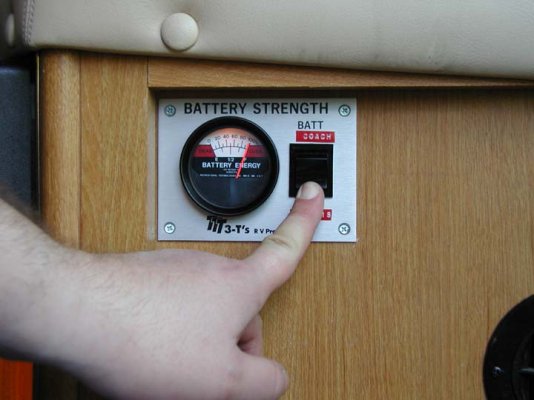rsalhus
Well-known member
- Joined
- Jul 20, 2006
- Posts
- 1,335
I just read the article on Battery Basics in the Sept issue of Motorhome magazine. It's pretty good reading but it doesn't cover some things RVers need to know. For instance, the article contains a State of Charge (SOC) table for lead-acid batteries showing the 12V battery readings when the battery is at 100%, 90%, 80%, etc., SOC. For RVers, this table will allow you to determine your batteries' SOC from a digital volmeter reading. For deep-cycle batteries, you know you don't want to discharge your batteries below 50% Depth of Discharge (DOD) before recharging them. Let's say you're out boondocking, and you've just stayed the first of several nights. You wake up the next morning and go out and measure your coach batteries and find that they're at 12.25 volts, indicating a 50% SOC. So you hook up the battery charger to the coach batteries and fire up the generator to charge them up. But you don't know how long it's going to take to charge them to a full charge, right? This is what the article is missing.
For me, I've installed a battery gauge in our RV (see the link at the bottom for a picture) which allows me to monitor the SOC of both the coach and chassis batteries. The Coach Batt/Chassis Batt switch on the battery gauge is a spring-loaded toggle switch that only displays the SOC (in percent) when the switch is held up (Coach batteries) or down (Chassis batteries). So it won't light up and display anything (and won't draw any current) when the toggle switch is released. The battery gauge is made by Recreational Technologies, Inc. right here in Minneapolis.
OK, now comes the interesting part. With the instructions for installing the battery gauge, is a formula for determining how long to charge the batteries based on the batteries' current SOC. The formula is as follows:
Charging time (hours) = Battery size (AH) X (100 - SOC reading in %) X .01
----------------------------------------------------------------------------
.7 X Charger current (Amps)
So an 80 AmpHour battery with a SOC reading of 50% and a 10 Amp battery charger would be:
Charging time (hours) = 80 X (100 - 50) X .01
----------------------------- = 5.7 hours
.7 X 10
So I would need to charge my coach battery (I actually have two) for 5.7 hours to get it up to full charge. Of course, you don't need the battery gauge to determine your batteries' SOC, you just have to measure the voltage and convert it to a SOC value (from the table in the article) and plug it into the formula. But I can just push a button in my MH and then do the computation needed. One thing to consider, the batteries should be at rest for at least three hours before reading them. If you need a copy of the SOC table or have any questions, I can be reached by e-mail.
For me, I've installed a battery gauge in our RV (see the link at the bottom for a picture) which allows me to monitor the SOC of both the coach and chassis batteries. The Coach Batt/Chassis Batt switch on the battery gauge is a spring-loaded toggle switch that only displays the SOC (in percent) when the switch is held up (Coach batteries) or down (Chassis batteries). So it won't light up and display anything (and won't draw any current) when the toggle switch is released. The battery gauge is made by Recreational Technologies, Inc. right here in Minneapolis.
OK, now comes the interesting part. With the instructions for installing the battery gauge, is a formula for determining how long to charge the batteries based on the batteries' current SOC. The formula is as follows:
Charging time (hours) = Battery size (AH) X (100 - SOC reading in %) X .01
----------------------------------------------------------------------------
.7 X Charger current (Amps)
So an 80 AmpHour battery with a SOC reading of 50% and a 10 Amp battery charger would be:
Charging time (hours) = 80 X (100 - 50) X .01
----------------------------- = 5.7 hours
.7 X 10
So I would need to charge my coach battery (I actually have two) for 5.7 hours to get it up to full charge. Of course, you don't need the battery gauge to determine your batteries' SOC, you just have to measure the voltage and convert it to a SOC value (from the table in the article) and plug it into the formula. But I can just push a button in my MH and then do the computation needed. One thing to consider, the batteries should be at rest for at least three hours before reading them. If you need a copy of the SOC table or have any questions, I can be reached by e-mail.

